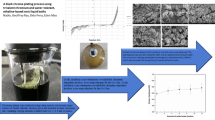Abstract
Electrodeposition of chromium from both CrCl2- and CrCl3-containing dimethylformamide (DMF)–water solutions is studied. It is found that the process of chromium deposition from Cr(II)-containing solutions is stable during the whole period of electrolysis, while the rate of electrodeposition from Cr(III)-containing electrolytes gradually decreases. To explain the experimental results, it has been assumed that the film consisting of chromium oxide and hydroxide species is formed in the near-cathode region during electrolysis in Cr(III)-based baths. The physical properties of this film are critical for chromium electrodeposition. It is necessary to maintain the negative potential sufficient for Cr(II)→Cr electroreduction at the electrode-film interface for the sustained chromium plating. Under such conditions, thick (up to 100 μm) Cr–C coatings of good quality can be deposited.






Similar content being viewed by others
Change history
15 June 2020
This original article contained a mistake. The page numbers of reference Kuznetsov et al. 2000 are incorrect, ���853���858��� should be ���756���760���.
Notes
Here and further, unless otherwise stated, all potentials are given against the standard hydrogen electrode (SHE)
References
Kuznetsov VV, Pavlov LN, Vinokurov EG, Filatova EA, Kudryavtsev VN (2015) Corrosion resistance of Cr–C–W alloys produced by electrodeposition. J Solid State Electrochem 19:2545–2553
Gamburg YD, Zangari G (2011) Theory and practice of metal electrodeposition. Springer, New York
Vinokurov EG, Kuznetsov VV, Bondar VV (2004) Aqueous solutions of chromium(III) sulfate. Modeling of equilibrium composition and physicochemical properties. Russ J Coord Chem 30:496–504
Wijenberg JHOJ, Steegh M, Aarnts MP, Lammers KR, Mol JMC (2015) Electrodeposition of mixed chromium metal-carbide-oxide coatings from trivalent chromium-formate electrolyte without a buffering agent. Electrochim Acta 173:819–882
Kuznetsov VV, Vinokurov EG, Kudryavtsev VN (2000) Effect of hydrodynamic electrolysis conditions on the kinetics of cathodic processes in Cr(III) sulphate electrolytes. Russ J Electrochem 36:853–858
Safonova OV, Vykhodtseva LN, Polyakov NA, Swarbrick JC, Sikora M, Glatsel P, Safonov VA (2010) Chemical composition and structural transformations of amorphous chromium coatings electrodeposited from Cr(III) electrolytes. Electrochim Acta 56:145–115
Edigaryan AA, Safonov VA, Lubnin EN, Vykhodtseva LN, Chusova GE, Polukarov YM (2002) Properties and preparation of amorphous chromium carbide electroplates. Electrochim Acta 47:2775–2786
El-Sharif MR, McDougall J, Chisholm CU (1999) Electrodeposition of thick chromium coatings from an environmentally acceptable chromium(III)-glycine complex. Trans IMF 77:139–144
El-Sharif MR, Watson A, Chisholm CU (1988) The sustained deposition of thick coatings of chromium/nickel and chromium/nickel/iron alloys and their properties. Trans IMF 66:34–40
He X, Zhu Q, Hou B, Li C, Jiang Y, Zhang Ch WL (2015) Electrodeposition of nanocrystalline coatings from 1-butyl-3-methylimidazolium-hydrogen sulfate ionic liquid. Surf Coat Technol 262:148–153
Ferreira ESC, Pereira CM, Silva AF (2013) Electrochemical studies of metallic chromium electrodeposition from a Cr(III) bath. J Electroanal Chem 707:52–58
Handy SL, Oduoza SF, Pearson T (2006) Theoretical aspects of electrodeposition of decorative chromium from trivalent electrolytes and corrosion rate study of different nickel/chromium coatings. Trans IMF 84:300–308
Protsenko V, Danilov F (2009) Kinetics and mechanism of chromium electrodeposition from formate and oxalate solutions of Cr(III) compounds. Electrochim Acta 54:5666–5672
Korshunov VN, Safonov VA, Vykhodtseva LN (2008) Structural features of the electrode/solution interface at the reduction of Cr3+(aq) cations on liquid mercury and solid indium electrodes in acidic media. Russ J Electrochem 44:255–264
Protsenko VS, Kityk AA, Danilov FI (2014) Kinetics and mechanism of chromium electrodeposition from methanesulfonate solutions of Cr(III) salts. Surf Eng Appl Electrochem 50:384–389
Vinokurov EG, Kudryavtsev VN, Bondar VV (1992) Composition of the layers adjacent to the electrode in plating electrolytes based on chromium(III) compound. Russ J Electrochem 29:851–857
Vinokurov EG, Demidov AV, Bondar VV (2005) Physicochemical model for choosing complexes for chromium-plating solutions based on Cr(III) compounds. Russ J Coord Chem 31:14–18
Vinokurov EG (2010) Thermodynamic probability model of ligand selection in solutions designed for electrodeposition of alloys and multivalent metals. Prot Met Phys Chem+ 46:615–619
Song YB, Chin D–T (2002) Current efficiency and polarization behavior of trivalent chromium deposition process. Electrochim Acta 48:349–356
Vinokurov EG, Kudryavtsev VN (1992) Procedure peculiarities in preparing electrolytes based on Cr(III) salts. Zaschita Metallov 28:331–334 (in Russian)
Kasian OI, Luk’yanenko TV, Velichenko AB (2013) Anodic oxidation of Cr3+ ions in a chromium electroplating bath on Pt and composite TiO x /PtO y . Russ J Electrochem 49:1165–1170
Kuznetsov VV, Kladiti SY, Filatova EA, Kolesnikov AV (2014) Electrochemical behavior of manganese and molybdenum mixed-oxide anodes in chloride and sulfate containing solutions. Mendeleev Commun 24:365–367
Scribner LL, Taylor SR (eds) (1990) The measurement and correction of electrolyte resistance in electrochemical tests. ASTM, Philadelphia
Protsenko VS, Gordienko VO, Danilov FI (2012) Unusual “chemical” mechanism of carbon co-deposition in Cr–C alloy electrodeposition process from trivalent chromium bath. Electrochem Commun 17:85–87
Torapava N, Radkevich A, Davydov D, Titov A, Persson I (2009) Composition and structure of polynuclear chromium(III) hydroxo complexes. Inorg Chem 48:10383–10388
Watson A, Anderson AMH, El-Sharif MR, Chisholm CU (1991) Role of chromium II catalysed olation reactions in the sustained deposition of chromium and its alloys from environmentally acceptable chromium III electrolytes. Trans IMF 69:26–32
Atlas of Eh−pH diagrams (2005) National Institute of Advanced Industrial Science and Technology, Naoto TAKENO, Tsukuba. http://www.eosremediation.com/download/Chemistry/Chemical%20Properties/Eh_pH_Diagrams.pdf
Kuznetsov VV, Turaev DY, Kruglikov SS, Kudryavtsev VN (2004) Application of ion-exchange membranes for stabilizing acidity of a chromium-plating electrolyte based on chromium(III) sulfate. Russ J Electrochem 40:1024–1028
Acknowledgements
Ministery of Education and Science of Russian Federation, 4.4584.2017/BY.
Author information
Authors and Affiliations
Corresponding author
Rights and permissions
About this article
Cite this article
Kuznetsov, V.V., Pavlov, L.N., Filatova, E.A. et al. Peculiarities of chromium electrodeposition from water − dimethylformamide solutions. J Solid State Electrochem 22, 217–225 (2018). https://doi.org/10.1007/s10008-017-3728-7
Received:
Revised:
Accepted:
Published:
Issue Date:
DOI: https://doi.org/10.1007/s10008-017-3728-7




